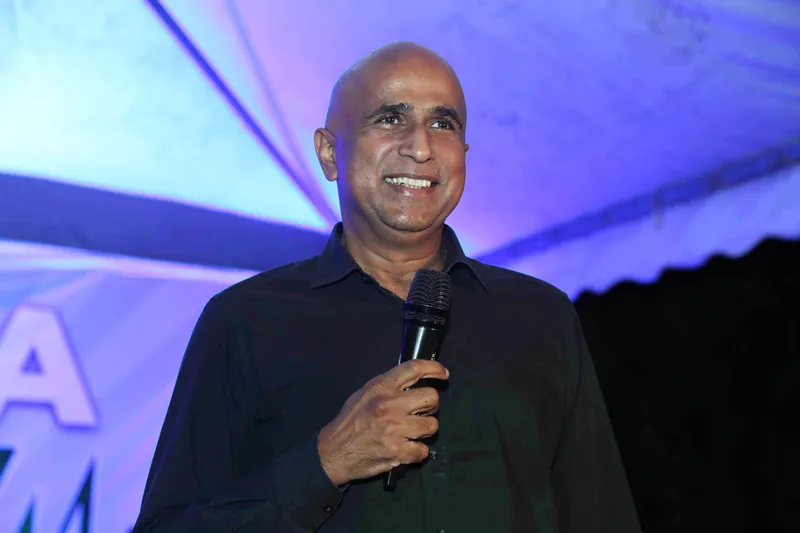Big Basket promoter K Ganesh’s debut book ‘Mastering Disruption’ is a handbook for every aspiring entrepreneur
Disruption can often feel overwhelming because of its rapid pace and unpredictable nature, but businesses can embrace it by paying attention to the early signals of change and listening keenly to customers and the market at large, says K Ganesh, serial entrepreneur and author of Mastering Disruption – A Practical Guide to Understanding New-age Business Models.
“Disruption rarely happens overnight. In most cases, there are leading indicators—small shifts in customer preferences, technological advancements, or new competitors emerging from unexpected places. Companies that keep their antennas up, pay attention to these signals, and listen to customers and the broader market can often spot disruptions early enough to act,” he tells YS Life.
Ganesh is the promoter and founder director of BigBasket, Portea Medical, Bluestone, and HomeLane, and other new-age tech companies. He is also the founder and partner at GrowthStory.in, a venture builder platform that incubates and promotes new ventures and entrepreneurs.
In his debut book Mastering Disruption – A Practical Guide to Understanding New-age Business Models, Ganesh decodes different approaches and strategies that businesses can adopt to tackle disruption and change and thrive in a rapidly evolving economic landscape.
He also delves into the various aspects of new-age business models, changing consumer behaviour, building strong customer relationships, and how Digital Public Infrastructure and India Stack have significantly lowered the barriers for entrepreneurs.
In the book, Ganesh urges new-age companies to track actionable metrics including customer acquisition cost, lifetime value, and contribution margins, and not be swayed by vanity metrics such as app downloads, page views, and social media followers.
The inspiration for Mastering Disruption came from Ganesh’s experiences while launching, scaling, and successfully exiting ventures such as BigBasket, Bluestone, and HomeLane, as well as from his years of teaching emerging business models at IIM Bangalore.
Written in a lucid manner, the book follows a structured and systematic approach, encapsulating key takeaways at the end of each discussion. Enriched with examples of successes, failures, and pivots, and relevant case studies, the book serves as a useful primer to entrepreneurs, business professionals, investors, and anyone with skin in the game.
Ganesh shares his thoughts on how businesses can unlock the potential of disruptive technologies and the big transformations he foresees in the coming years.
Edited excerpts:
YS Life [YSL]: What led you to pen ‘Mastering Disruption’? Who will benefit from it?
K Ganesh [KG]: I have seen firsthand how new-age businesses can disrupt traditional industries and wanted to share these lessons in a practical framework to guide entrepreneurs, professionals, and investors as they navigate this dynamic environment.
Entrepreneurs and startup founders can gain actionable insights into building scalable business models. Corporate professionals can learn how to integrate disruptive innovations within established organisations. Management students will find the book helpful in understanding the mechanics behind modern business success. Investors and policymakers can use the frameworks to assess the risks and opportunities in emerging sectors.
The book’s value lies not only in explaining new business models but in helping readers understand how to adapt them to local contexts and challenges.
YSL: In your book, you call the velocity of disruption ‘daunting.’ How can businesses—new-age or traditional—embrace disruption and unlock its potential without fear or panic?
KG: Disruption is typically driven by technological advancements, shifting customer expectations, and external factors like macroeconomic or geopolitical changes. Companies can anticipate and prepare for these shifts by constantly engaging with emerging technologies such as AI, blockchain, and IoT. These innovations allow businesses to rethink their products and processes and discover opportunities.
Technology is no longer just an enabler—it’s central to strategy. Companies that embed it deeply into their operations can unlock new capabilities and continuously improve.
Agility is key to thriving in this hyper-competitive environment, where products can quickly become obsolete. Businesses that follow an iterative approach—experimenting with prototypes, gathering feedback, and making quick adjustments—tend to be more successful. Fostering a ‘fail-fast, learn-fast’ culture is essential, where failures are not viewed as setbacks but as learning opportunities that fuel innovation.
In an environment of shorter product lifecycles, businesses must be prepared to constantly reinvent themselves. Companies that rely on past successes without evolving risk becoming obsolete. Organisations like Tata Group have remained relevant by pursuing strategic acquisitions and driving internal innovation.
Businesses must stay agile, data-driven, and customer-focused to harness the power of disruption rather than be overwhelmed by it.

In his book 'Mastering Disruption', serial entrepreneur K Ganesh covers the evolution of software-as-a-service, fintech, and the emerging creator economy, which, he says, present not only new opportunities for building businesses but also avenues for traditional companies to incorporate disruptive models into their operations.
YSL: Entrepreneurs are always in search of the next big idea. Does an idea have to be audacious to create impact, or can a simple idea work too?
KG: If you’re aiming for a venture-backed, high-scale business, you’ll need to focus on attracting risk capital, scaling quickly, and having a potential exit strategy through acquisition or IPO. You’ll need audacious ideas that can disrupt industries. These ideas often come with high risks, but if they succeed, they can do so on a massive scale.
However, if you’re building a more traditional or sustainable business, you don’t need an audacious, world-changing idea. What you need to do is solve a real problem or address a major pain point. The simpler the idea, the better. Look around—see what people are struggling with every day. What inconveniences do they
face? What can you do to ease their pain or give them something they need and will be willing to pay for?
YSL: What tenets should new-age businesses nurture to thrive amid constant change?
KG: Adaptability: Companies must be willing to pivot and adapt to new opportunities or threats.
Customer obsession: Successful businesses keep the customer at the centre of every decision. Amazon excels at this with its data-driven approach; everything from product recommendations to delivery options is tailored to customer needs.
Sustainable scaling: Scaling too fast without managing costs can be a recipe for failure. Businesses should focus on managing burn rates and ensuring they hit key profitability milestones.
Focus on talent: Companies need diverse and agile teams that can anticipate change and respond quickly. As industries evolve, businesses must continuously upskill their workforce and hire talent capable of driving innovation.
Atomic Habits, The Hard Thing About Hard Things: What India's startup leaders are reading in 2024
YSL: Your book touches upon metrics like CAC, ARPU, and virality? How crucial are these in new-age business models?
KG: In new-age business models, the drivers of success often revolve around network effects, customer retention, and user engagement rather than fixed-cost optimisation. Metrics like virality coefficient, lifetime value (LTV), churn rate, and retention rate play a critical role in understanding and predicting business outcomes.
For example, in a subscription-based business, even if the customer acquisition cost (CAC) is high and the initial average revenue per user (ARPU) is low, a company can still build a valuable and profitable business if it maintains high retention rates. A high LTV can offset the initial high CAC over time, leading to sustainable growth.
Vanity metrics, such as app downloads, page views, or social media followers, may provide short-term validation, particularly when raising funds in the initial stages. However, relying on them for too long without focusing on real metrics like CAC, LTV, and contribution margins can lead to sustainability challenges. Many startups that scaled quickly based on vanity metrics struggled to sustain themselves due to inadequate focus on core business fundamentals.
Additionally, businesses must distinguish between leading and lagging metrics. Lagging metrics, such as revenue or churn rate, show what has already happened and are important for assessing outcomes. But they don’t always help in preventing future issues.
Leading metrics, on the other hand, act as early warning signals. For example, if a company faces high customer churn, it should examine leading metrics like net promoter score, time taken for the first transaction after sign-up, or product engagement levels. By addressing leading metrics, businesses can improve retention rates and prevent churn.
YSL: How should businesses approach digital transformation and capitalise on digital public goods?
KG: Businesses should approach digital transformation with a strategic mindset that leverages digital public goods (DPGs) and digital public infrastructure (DPI) to reduce operational complexity, lower capital requirements, and enable rapid scaling. Today, DPGs and DPI provide plug-and-play modules that allow businesses to scale quickly without having to reinvent the wheel.
For instance, a D2C brand can launch with minimal infrastructure by integrating various public and private digital systems seamlessly. It can sell products on ONDC (Open Network for Digital Commerce) without creating its own ecommerce platform; use service providers for logistics and delivery rather than building its own supply chain; integrate payments using UPI, Razorpay, or Paytm; and rely on third-party warehousing services for inventory management.
This modular ‘Lego block’ approach reduces time-to-market and capital investment, allowing startups to focus on delivering unique value.
Autorickshaw aggregator Namma Yatri used DPI to challenge established players like Uber and Ola, proving that disruptive innovation does not always require massive capital investments—it requires smart use of public infrastructure.
YSL: What major disruptions do you foresee in the coming years?
KG: First, agentic AI solutions in organisational processes. Companies will begin to unbundle tasks traditionally performed by humans into smaller, modular tasks that can be assigned to AI agents working autonomously or collaboratively.
These agents will not just automate repetitive tasks, but also take on complex, goal-oriented processes such as project management and operational optimisation. Human employees will be freed from routine tasks, enabling them to focus on creative problem-solving and innovation.
Second, secondary business opportunities in clean energy. The clean energy revolution will go beyond renewable energy and electric vehicles (EV) to drive demand for related industries, such as battery technology, energy storage, grid integration, and recycling.
Governments are expected to introduce stricter regulations on battery disposal and recycling, creating compliance-driven opportunities for businesses in waste management and resource recovery.
Cross-sectoral innovations will emerge—such as solar-powered EV charging stations, vehicle-to-grid energy transfer, and improved energy storage solutions.
Third, a modular, collaborative approach. The traditional model of vertically integrated companies controlling every aspect of the value chain is giving way to modular ecosystems, facilitating faster innovation, scalability, and cost-sharing.
Companies will focus on core competencies and collaborate with external players to build end-to-end solutions. Instead of manufacturing every component in-house, a company may specialise in a single part of the value chain—such as software, hardware, or logistics—and connect with other players through interoperable systems.
This collaborative model lowers entry barriers, encourages innovation, and expands the overall market size. For instance, in the fintech space, open banking APIs allow smaller financial startups to integrate seamlessly with traditional banking infrastructure, creating hybrid ecosystems where collaboration and competition coexist.
Edited by Affirunisa Kankudti







